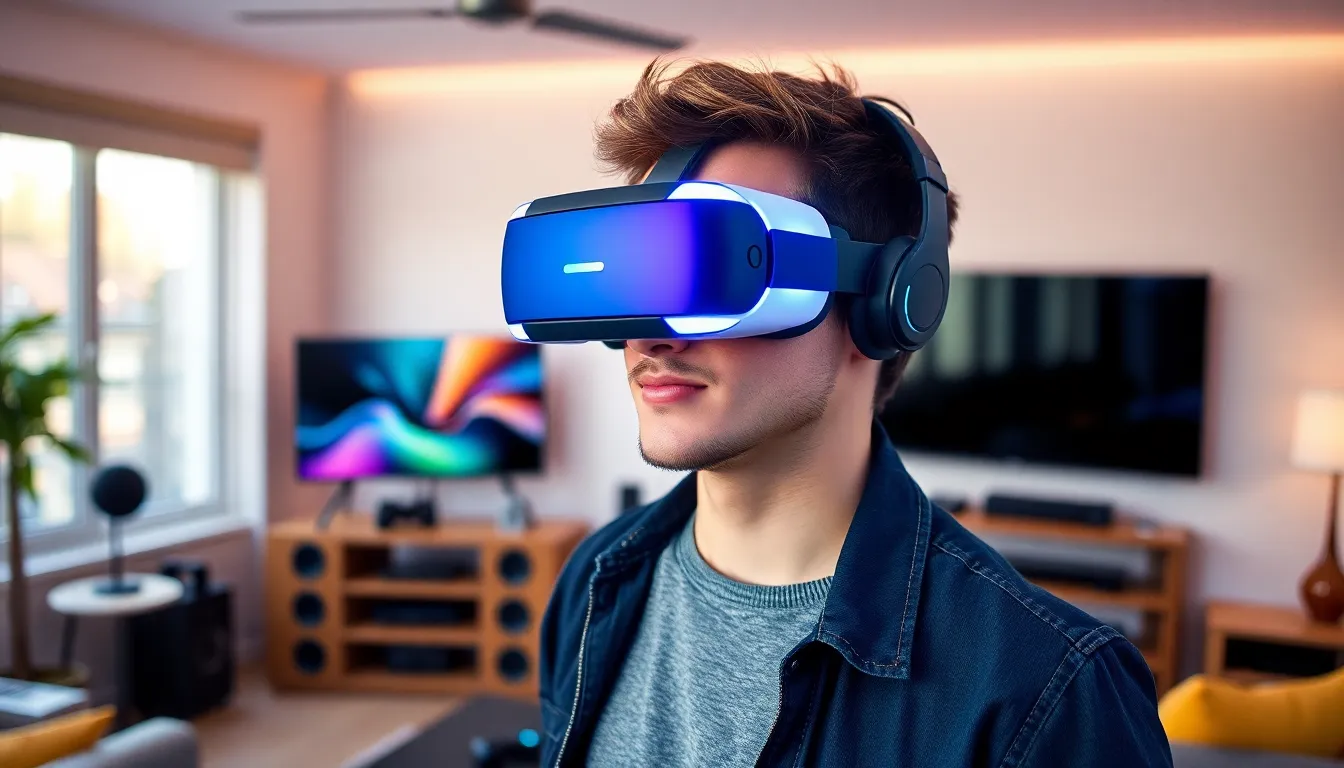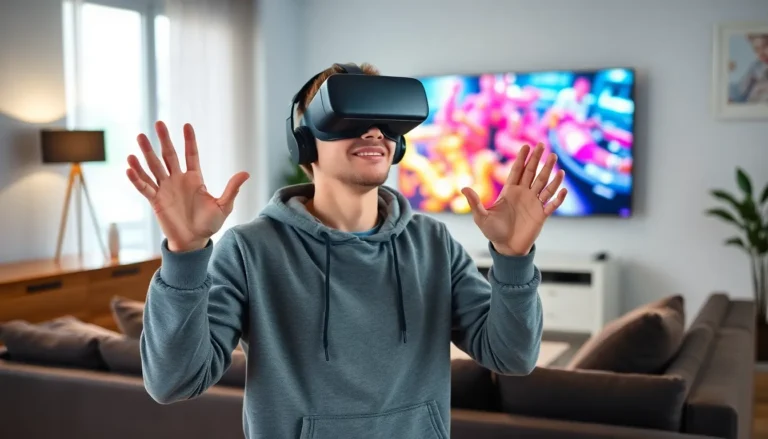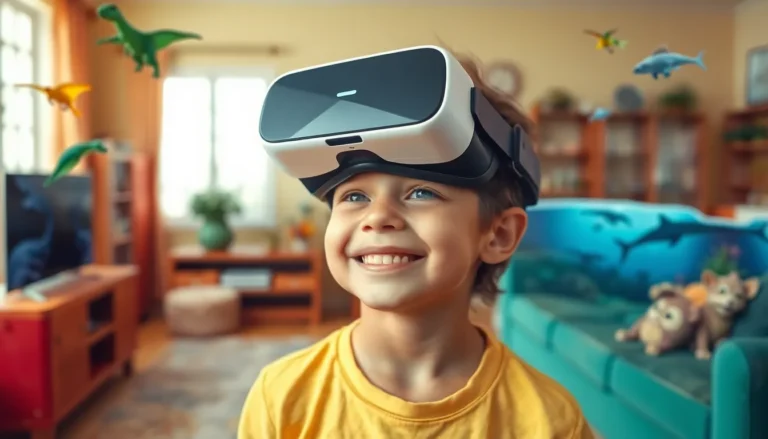Ever wondered how those fancy VR headsets transport you to a galaxy far, far away or a dinosaur-infested jungle? It’s like magic but with a sprinkle of science. These high-tech gadgets blend cutting-edge technology and creativity to create immersive experiences that make reality seem a bit dull in comparison.
Table of Contents
ToggleUnderstanding VR Technology
Virtual reality technology immerses users in a computer-generated environment through headsets. This technology combines hardware and software to create realistic experiences.
Definition of Virtual Reality
Virtual reality refers to a simulated environment that users can interact with through sensory experiences. It integrates visual, auditory, and sometimes haptic feedback to replicate real-world or imaginary settings. Users wear VR headsets, which contain screens displaying 3D images, while sensors track head movements for a dynamic perspective change. Such interactions make virtual environments immersive and engaging, giving users a sense of presence.
Brief History of VR Development
Virtual reality has roots that trace back to the 1960s, with early systems like the Sensorama created by Morton Heilig. Fast forward to the 1980s, Jaron Lanier popularized the term “virtual reality” and launched commercial VR devices. The 1990s saw significant advancements with products like Sega’s VR headset, although they had limited success. Modern VR gained traction in the 2010s, driven by companies like Oculus with the Rift headset, which established a new wave of interest. Today, VR technology encompasses gaming, healthcare, education, and more, illustrating its versatile applications across industries.
Components of VR Headsets

VR headsets integrate multiple components to deliver immersive experiences. These components work together to create lifelike interactions in virtual environments.
Display Technology
Display technology forms the backbone of VR headsets. OLED and LCD panels often serve as the primary screen types, allowing for high-resolution images. These displays showcase content at refresh rates typically ranging from 60 to 120 Hertz, which reduces motion blur. Individual screens for each eye enhance depth perception by providing slightly different images, simulating real-world viewing. Advanced models sometimes include features like foveated rendering, which improves performance by focusing processing power on the user’s direct line of sight.
Optics Used in VR
Optics play a crucial role in providing a clear view of the virtual world. Lenses, usually made from high-quality glass or plastic, adjust the focal length to correct distortion and enhance image quality. Fresnel lenses are common due to their lightweight and slim profile, optimizing the design of the headset. Proper lens spacing is vital for accommodating different interpupillary distances, ensuring comfort for each user. Together, these optics help transform flat images into three-dimensional visuals, significantly enhancing immersion.
Tracking Systems
Tracking systems enable precise movement detection in VR environments. Inertial measurement units (IMUs) are often employed to measure acceleration and angular velocity. These sensors help track the user’s head movements in real time, enabling a 360-degree experience. Outside-in tracking systems use external cameras to monitor the position, while inside-out tracking relies on built-in cameras to map the surrounding area. Each method contributes to a seamless experience by minimizing lag and ensuring accurate interaction in virtual spaces.
How VR Headsets Create Immersion
VR headsets create immersion through a combination of advanced technologies that engage multiple senses. Key components like stereoscopic vision and head tracking contribute significantly to this experience.
Stereoscopic Vision
Stereoscopic vision mirrors the way humans perceive depth in the real world. Each eye sees a slightly different angle, providing depth information crucial for an immersive experience. VR headsets utilize two separate displays or lenses to present unique images for each eye. This technique enhances the illusion of three-dimensional space, making virtual environments feel more realistic and engaging. Gamers and movie watchers particularly benefit from this visual depth, which heightens their overall enjoyment.
Field of View and Depth Perception
Field of view defines how much of the virtual world users can see at once. A wider field of view allows for a more encompassing experience, similar to natural human vision. Depth perception is enhanced through the combination of stereoscopic vision and spatial elements. Users can better judge distances and navigate spaces, leading to a more intuitive interaction with virtual objects. High-quality headsets offer field of view ranges between 90 and 110 degrees, maximizing immersion for activities like gaming or training simulations.
Head Tracking and Motion Sensing
Head tracking involves continuously monitoring users’ head movements to adjust the virtual environment accordingly. Advanced sensors pick up even slight shifts or rotations, providing real-time feedback. This tracking ensures the virtual world aligns with users’ gaze and movements, enhancing immersion. Motion sensing, through external cameras or sensors, captures body movements for a fully responsive experience. Together, these technologies facilitate seamless transitions and interactions within a virtual space.
Types of VR Headsets
VR headsets come in various types, each serving distinct purposes and audiences. Understanding these options helps users choose the most suitable headset for their needs.
Tethered VR Headsets
Tethered VR headsets connect directly to powerful gaming PCs or consoles. They rely on high-performance hardware to deliver stunning graphics and immersive experiences. Examples include the Oculus Rift S and HTC Vive Pro, both of which offer extensive libraries of games and applications. Users enjoy superior visuals and fluid motion tracking thanks to advanced sensors. These devices often require a dedicated play area, facilitating room-scale experiences. Additionally, they typically support high refresh rates, minimizing lag and enhancing realism during intense gaming sessions.
Standalone VR Headsets
Standalone VR headsets operate independently without the need for external hardware. Equipped with built-in processors and storage, devices like the Oculus Quest 2 exemplify this category. Users appreciate the convenience of portability and ease of setup. Enhanced tracking systems allow for six degrees of freedom, enabling users to move freely in virtual spaces. Furthermore, standalone headsets support downloadable content, ensuring access to a variety of applications and games. Battery life typically ranges from two to three hours, providing ample time for immersive experiences.
Mobile VR Headsets
Mobile VR headsets function primarily by utilizing smartphones as displays. These devices, such as Samsung Gear VR, offer accessibility for users who don’t own high-end gaming equipment. Users can quickly slip their phones into the headset, making the experience both portable and user-friendly. Content libraries may include games, educational applications, and immersive media. While mobile headsets lack the performance of tethered options, they excel in providing an introduction to virtual reality. Battery life depends on the smartphone used, making efficient power management crucial for extended sessions.
VR headsets have revolutionized the way people experience digital environments. By combining advanced technology with creative design, these devices transport users into immersive worlds that engage the senses. The intricate mechanics of display technology, optics, and tracking systems work together to create realistic interactions and experiences.
As VR continues to evolve, the variety of headsets available caters to a wide range of preferences and needs. Whether for gaming, education, or healthcare, the applications of VR technology are expanding rapidly. This innovation not only enhances entertainment but also opens new avenues for learning and interaction, making virtual reality an exciting frontier in technology.




